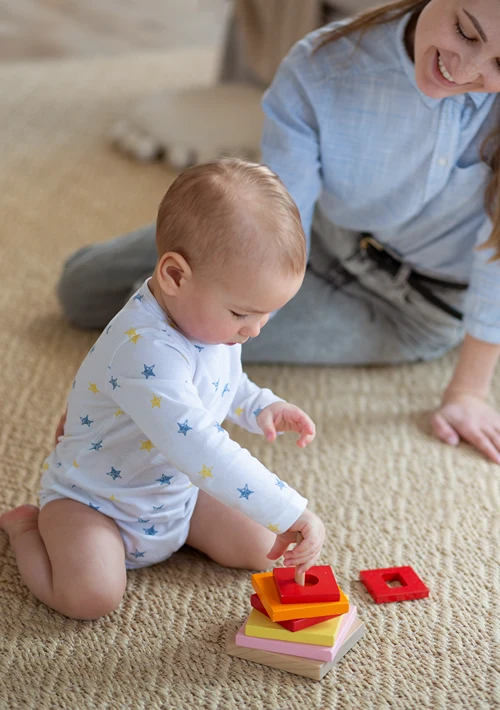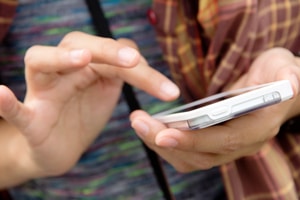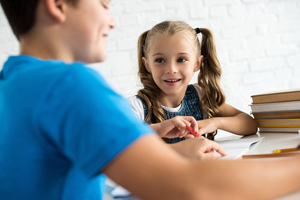Baby Sensory Activities: A Guide to Promote Healthy Development
Baby sensory activities help your baby explore the world around them, improve their overall well-being, and develop their cognitive, physical, and emotional skills. For example, activities like music, tummy time, and playing with sensory toys are essential for your baby’s healthy development.
There are many different sensory activities you can try with your baby, but there is one common thread underlying them all: your baby is the doer, not the passive watcher. Your baby must be the one doing the exploring, not idly sitting by watching things happen.
For more on why this is important, read Are Montessori Toys Better for My Baby? There, we thoroughly explain sensory toys and their role in a child’s early development.
Here are some of the most popular baby sensory activities you can do at home anytime.
1. Tummy Time
Tummy time is crucial for babies because it helps them develop their neck, back, and shoulder muscles. At first, a baby will only be able to lift his or her head, but with some time and practice, he or she will begin pushing up onto their hands for a better view and even roll over.
You can make tummy time more sensory by placing different textures and toys around your baby to encourage them to reach and explore. One of the easiest ways to do this is by laying your baby on a quilt with blocks of various fabric colors and textures. Placing a sensory toy or two nearby will give your baby something to move toward and grasp.
As your baby grows and becomes more able-bodied and mobile, you can prepare an area on the floor with lots of fun things for little hands to feel.
2. Sensory Bins
Sensory bins are containers filled with materials your baby can touch and explore. You can fill these bins with rice, sand, or water and add toys to encourage exploration. Baby should be able to sit up before introducing this activity.
Be mindful that the bin should be heavier than your baby because he or she may attempt to pull up or push up on the side. Also, most babies will try to explore these little bits with their mouths. You should be right beside your little one as he or she experiences small materials.
Here are a few ideas:
- sponges in water
- measuring cups in sand
- glitter and water in a closed water bottle
- marbles in a sealed bottle
- different materials glued to a piece of cardboard
- ice cubes in a bowl
- frozen peas in a bowl
For babies not yet sitting up, you can fill bottles with marbles, bubbles, glitter, or rice, glue the lid back on the top, and let your baby roll it around. Another option is to fill a Ziploc bag with something interesting (frozen peas, colored dots, cornstarch and water, etc.) and let your little one squeeze and mash it.
3. Music and Singing
Babies love music and singing! Whether you play a song on your phone or sing to baby yourself, your little one will relish listening to melodies and watching you sing to them or dance.
You will also encourage your baby to listen and explore by listening to various types of music. Encourage even more giggles and connection by picking baby up and dancing together! It is such a joy when your little one bounces and dances to his or her favorite tunes.
4. Mirror Games
Place your baby in front of a well-secured mirror or hold a hand-held mirror in front of them so they can see their own reflection and interact with it. Some baby toys come with an unbreakable mirror for your baby to handle and giggle at.
You can go a step further by sitting behind your baby while naming and pointing at parts of your baby’s body or naming emotions as you show them with your own face in the mirror. As they get older, you can even ask them to point to their eyes, nose, mouth, and ears or make those funny faces in the mirror.
Mirror games are excellent for helping your little one develop body awareness, see emotions, and connect with you.
5. Look at Pictures
Looking at and talking about pictures in a photo album, around the house, or in a picture book is a wonderful way to tell your little one about their family members, friends, and the world beyond the walls of your home.
Before your baby can communicate with words, facial expressions help him or her understand. Smiling, in particular, represents safety and security in a healthy family. By sharing about family and friends with your little one as you show their smiling faces in pictures, you are helping them recognize smiles and eventually foster a sense of belonging.
6. Watch Moving Objects
Watching moving objects like fan blades, leaves blowing in the breeze, or shadows on a wall is fantastic for capturing and holding your baby’s attention. Focusing on movement helps your little one develop object-tracking skills visually.
Taking your baby for a walk outside or simply sitting still in the backyard allows your baby to see movement that he or she will not see inside. At first, infants cannot see very far, but a baby’s eyesight is improving rapidly throughout the first year (source). There are several ways you can do this inside and outside–ensure you mix it up often!
7. Suck on Clean Toys
This seems like an odd one, but babies really like to explore by tasting everything. From sucking on fingers and pacifiers to chewing on everything while teething, sucking and chewing are important ways for babies to discover the world around them.
The trick is making sure your baby doesn’t get anything harmful or tiny into his or her mouth. You can do this preemptively by preparing a play area beforehand with safe toys for chewing and slobbering on. Moonkie’s silicone toys and teethers are perfect for this!




